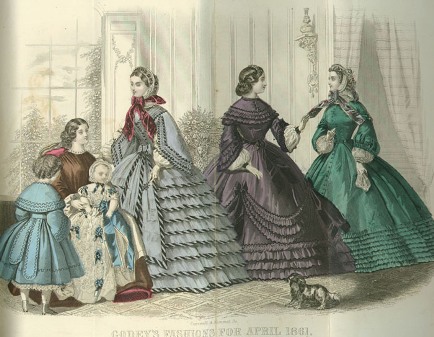1860's Period in Fashion History presented by Apparel Search
Fashion Industry Fashion History Definition List
1860s fashion in European and European-influenced clothing is characterized by extremely full-skirted women's fashions relying on crinolines and hoops and the emergence of "alternative fashions" under the influence of the Artistic Dress movement.
Women's fashions
By the early 1860s, skirts had reached their ultimate width.
Day dresses featured wide pagoda sleeves worn over undersleeves or engageantes. High necklines with lace or tatted collars or chemisettes completed the demure daytime look.
Evening dresses had low necklines and short sleeves, and were worn with short gloves or lace or crocheted fingerless mitts.
Heavy silks in solid colors became fashionable for both day and evening wear, and a skirt might be made with two bodices, one long-sleeved and high necked for afternoon wear and one short-sleeved and low-necked for evening.
As the decade progressed, sleeves narrowed, and the circular hoops of the 1850s decreased in size at the front and sides and increased at the back. Looped up overskirts revealed matching or contrasting underskirts, a look that would reach its ultimate expression the next two decades with the rise of the bustle.
Fashions were adopted more slowly in America than in Europe. It was not uncommon for fashion plates to appear in American women's magazines a year or more after they appeared in Paris or London.
Military and political influences
Following a visit by the Italian revolutionary Giuseppe Garibaldi to England in 1863, the Garibaldi jacket or Garibaldi shirt became all the rage. These bright red woolen garments featured black embroidery or braid and military details. In America, the early years of the Civil War also saw increased popularity of military-influenced styles such as Zouave jackets. These new styles were worn over a waist (blouse) or chemisette and a skirt with a belt at the natural waistline.
Rise of haute couture
The Englishman Charles Frederick Worth had established his first fashion house in Paris in 1858. He was the first couturier, a dressmaker considered an artist, and his ability to dictate design in the 1860s lead to the dominance of Parisian haute couture for the next hundred years.
Artistic dress
The followers of the Pre-Raphaelite Brotherhood and other artistic reformers objected to the elaborately trimmed confections of high fashion with their emphasis on rigid corsets and hoops as both ugly and dishonest. An "anti-fashion" for Artistic dress spread in the 1860s in literary and artistic circles, and remained an undercurrent for the rest of the century. The style was characterised by "medieval" influences such as juliette sleeves, the soft colors of vegetable dyes, narrow skirts, and simple ornamentation with hand embroidery.
Hairstyles and headgear
Bonnets for outdoor wear had small brims that revealed the face, and fell out of fashion over the decade in favor of small hats.
See also
Photo: Fashions of 1861 from Godey's Lady's Book. Image from http://www.gettysburg.edu/
Learn about another era in fashion:
1980's Fashion History (terms section)
| The above article is licensed under the GNU Free Documentation License. From Wikipedia, the free encyclopedia https://en.wikipedia.org/wiki/1860s_in_fashion 1/13/06 |
Designer Definition (from U.S Department of Labor)

